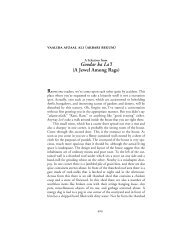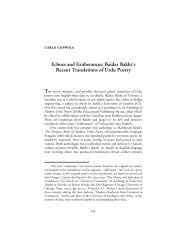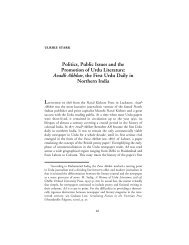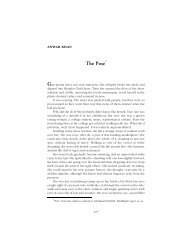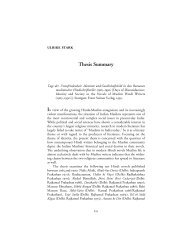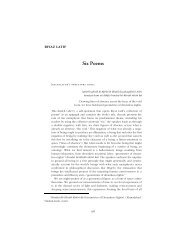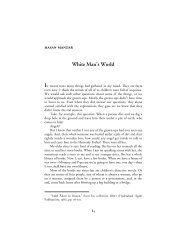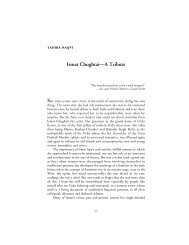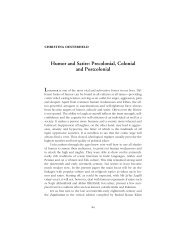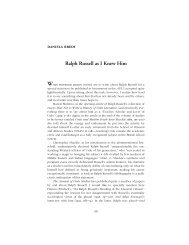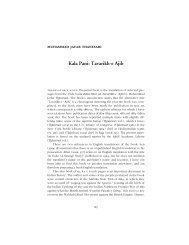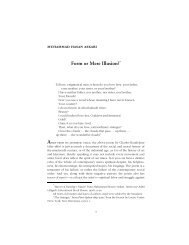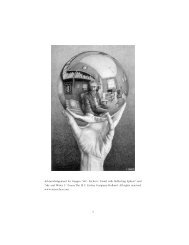Delhi College and Urdu* - MINDS@UW Home
Delhi College and Urdu* - MINDS@UW Home
Delhi College and Urdu* - MINDS@UW Home
You also want an ePaper? Increase the reach of your titles
YUMPU automatically turns print PDFs into web optimized ePapers that Google loves.
GAIL MINAULT • 133didactic novels, some of the first works in that form in Urdu. His firstnovel, Mir≥tu ’l-‘Ar∑s (The Bride’s Mirror, 1869), written originally for theinstruction of his daughters, won a prize from the British Indian governmentas a “useful work of literature in the vernacular.” 38 Another earlygraduate was Py≥r® L≥l “¥shåb,” known both as an Urdu poet <strong>and</strong> authorof the ethnography, Rus∑m-e Hind. 39Mu√ammad ƒusain ¥z≥d (1830–1910), the originator of literary criticismin Urdu, was another graduate of <strong>Delhi</strong> <strong>College</strong>. His father, MaulvµMu√ammad B≥qir, mentioned above as the proprietor of the Dehlµ Urd∑Akhb≥r, later supported the 1857 revolt <strong>and</strong> was executed by the British.Mu√ammad ƒusain ¥z≥d had worked for his father’s newspaper <strong>and</strong> fled<strong>Delhi</strong> after the revolt. He was later able to join government service in thePunjab <strong>and</strong> there wrote his major work, ¥b-e ƒay≥t, a history of Urdu literature.His judgments on the literature of the past bear the stamp of hiseducation, <strong>and</strong> his loss. As a great prose stylist, he often misjudged or disparagedthe poetic muse of others, although when evaluating poets, hetended to glorify the poets of <strong>Delhi</strong> over all others. He served as theSecretary of the Anjuman-e Panj≥b, a literary <strong>and</strong> educational reform associationin Lahore. Together with W.R.M. Holroyd, the Director ofPublic Instruction in the Punjab in the 1870s, <strong>and</strong> Alπ≥f ƒusain ƒ≥lµ,another Urdu poet with ties to <strong>Delhi</strong>, ¥z≥d helped institute a series ofmush≥‘iras in Lahore that promoted a new style of poetry, more topical<strong>and</strong> “natural” (according to English st<strong>and</strong>ards of the day) than the lyricalghazal. 40Yet another well-known graduate of <strong>Delhi</strong> <strong>College</strong> was Maulvµ Ÿak≥u’l-L≥h (1832–1911), scion of a family that had served as tutors to theMughal dynasty. Ÿak≥u ’l-L≥h taught mathematics <strong>and</strong> wrote prodigiously38 Iftikh≥r A√mad ¿iddµqµ, Maulvµ Naÿµr A√mad Dehlavµ: A√v≥l-o-¥¡≥r(Lahore: Majlis-e Taraqqµ-e Adab, 1971); C.M. Naim, “Prize-Winning Adab,” inBarbara Metcalf, ed., Moral Conduct <strong>and</strong> Authority: The Place of Adab in SouthAsian Islam (Berkeley: University of California Press, 1984), pp. 290–314.39 Py≥r® L≥l ¥shåb Dehlavµ, Rus∑m-e Hind (1868; rpt. Lahore: Majlis-eTaraqqµ-e Adab, 1961).40 C.M. Naim, “Mughal <strong>and</strong> British Patronage of Urdu Poetry: A Comparison,”in The Powers of Art: Patronage in Indian Culture, ed. Barbara S. Miller(<strong>Delhi</strong>: Oxford University Press, 1992), pp. 259–76; for a discussion of ¥z≥d <strong>and</strong>ƒ≥lµ’s literary criticism <strong>and</strong> the changing canons of taste, see Frances Pritchett,Nets of Awareness: Urdu Poetry <strong>and</strong> its Critics (Berkeley: University of CaliforniaPress, 1994), especially. pt. 3.



